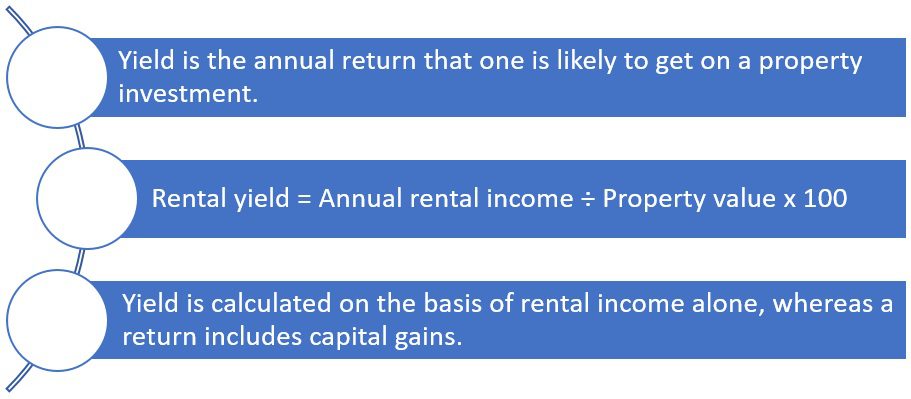Investors across the world refer to data points while making financial decisions. Whether it is the stock market or real estate investment, investors are always interested in knowing what return the investment will give. This return, in other words, is called yield.
Yield is the rate of return or the earnings generated on an investment over a period of time. It is also depicted as a percentage, depending upon the invested amount and current market value of the security. It also includes the total interest earned or dividends received from holding a particular security. For real estate, it is expressed as the annual income from the property.
Understanding yield

Real estate yield
This is a measurement of future income on an investment made on immovable property. It is calculated as a percentage, depending upon the cost of the property or its market value. The capital gain is not factored in here.
Gross rental yield
This is the income on an investment, before deducting the expenses incurred on the property’s maintenance. Since these expenses can be huge, there could be marked differences between the gross and net yields.
See also: Everything you need to know about income from house property
Real estate net yield
Net yield is the income on the property after deducting costs and expenses. These expenses may include costs such as stamp duty, legal feels or rent lost due to the property remaining vacant. Other expenses could be due to repairs or insurance.
Returns or total return yield
Return yield is the gain or loss made on an investment and it includes capital gains, as well. This can be expressed in currency or in percentage derived from the rate of profit to investment. This is focussed on the property’s past performance and not on its future earning potential.
Return vs yield: Difference
Mostly, yield is calculated only on the basis of rental income, whereas a return includes capital gains, as well. However, home buyers should clarify if the yields and returns are on an annual basis before making the purchasing decision.
See also: How to save tax on rental income
How to calculate yield?
Follow this procedure to calculate yield on your property:
Step 1: Calculate the net ongoing costs on your property and deduct it from the property’s annual rental income.
Step 2: Divide the amount calculated above from the property’s value.
Step 3: To get the percentage, multiple the result by 100.
Gross yield: Annual rental income/property value x 100
Net yield: Annual rental income- annual expenses and cost/property value x 100
Let us assume, you bought a property in 2020 for Rs 20 lakhs. You rent out the property for Rs 10,000 per month and have annual expenses of Rs 30,000 (repairs, maintenance charges, property tax, etc.). The annual rent earned will be Rs 1,20,000.
Net yield: 1,20,000-30,000/Rs 20 lakhs x 100 = 4.5%
Gross yield: 1,20,000/20 lakhs x 100 = 6%
FAQs
What is a good yield in property?
It depends on the location and type of property.
How is yield calculated?
Yield can be calculated by dividing the annual income from the investment/property and dividing it by the purchase price.
What is yield in property?
The yield of a property refers to the annual return that one is likely to get on an investment.






